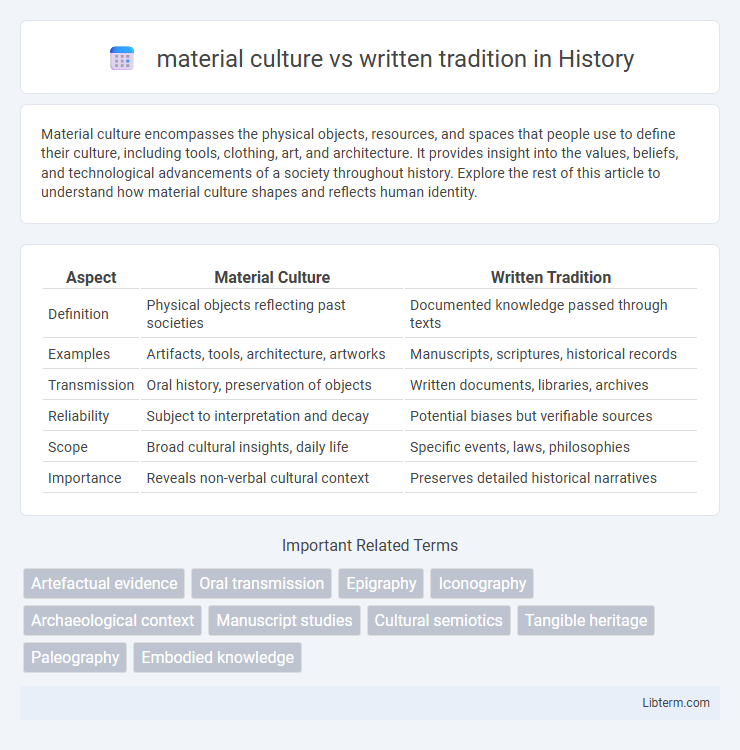Material culture encompasses the physical objects, resources, and spaces that people use to define their culture, including tools, clothing, art, and architecture. It provides insight into the values, beliefs, and technological advancements of a society throughout history. Explore the rest of this article to understand how material culture shapes and reflects human identity.
Table of Comparison
| Aspect | Material Culture | Written Tradition |
|---|---|---|
| Definition | Physical objects reflecting past societies | Documented knowledge passed through texts |
| Examples | Artifacts, tools, architecture, artworks | Manuscripts, scriptures, historical records |
| Transmission | Oral history, preservation of objects | Written documents, libraries, archives |
| Reliability | Subject to interpretation and decay | Potential biases but verifiable sources |
| Scope | Broad cultural insights, daily life | Specific events, laws, philosophies |
| Importance | Reveals non-verbal cultural context | Preserves detailed historical narratives |
Defining Material Culture and Written Tradition
Material culture encompasses the physical objects, artifacts, and spaces created and used by humans, reflecting social practices, beliefs, and historical contexts. Written tradition involves the transmission of knowledge, ideas, and cultural values through documented texts, manuscripts, and inscriptions that preserve language and intellectual heritage. Both material culture and written tradition provide complementary insights into past societies, with material culture offering tangible evidence and written tradition delivering contextual narratives.
Historical Roots of Material Culture
Material culture, deeply rooted in tangible artifacts such as tools, pottery, and architecture, provides direct evidence of past human activities and societal structures. Unlike written tradition, which relies on language and textual transmission, material culture offers non-verbal insights into daily life, technological advancements, and cultural interactions. Archaeological findings of material culture establish historical roots by revealing the evolution of civilizations independent of written records.
Evolution of Written Tradition
The evolution of written tradition traces the transition from oral storytelling to complex scripts and alphabets that preserve cultural knowledge across generations. Innovations such as cuneiform, hieroglyphics, and the Phoenician alphabet significantly enhanced record-keeping, communication, and the dissemination of ideas. This shift enabled the development of laws, literature, and historical documentation, shaping civilizations and influencing material culture preservation.
Tangibility: Artifacts vs. Texts
Material culture embodies tangibility through physical artifacts such as tools, clothing, and architecture that provide direct sensory engagement and concrete evidence of past societies. Written tradition, while intangible, preserves knowledge and narratives through texts like manuscripts, inscriptions, and codices that require interpretation but offer detailed context and continuity. The distinction between tactile objects and recorded words highlights different modes of historical transmission and cultural memory.
Functions in Knowledge Preservation
Material culture serves as a tangible repository for knowledge, encoding information through artifacts, architecture, and tools that convey cultural practices and social norms across generations. Written tradition systematically documents laws, histories, and scientific discoveries, enabling precise transmission and reference over time and space. Both forms complement each other in preserving diverse types of knowledge, with material culture offering contextual experience and written texts providing explicit, durable records.
Social Influence and Identity Shaping
Material culture, encompassing artifacts, architecture, and everyday objects, actively shapes social influence by embodying shared values and norms that reinforce group identity within communities. Written tradition transmits cultural knowledge and social norms across generations, solidifying identity through recorded histories, laws, and literature that guide collective behavior. Both forms interact dynamically, with material culture providing tangible expression of identity while written tradition offers codified frameworks for societal roles and influence.
Interpretation Challenges and Biases
Material culture offers tangible artifacts that reveal daily life and social practices, yet interpretation is challenged by context loss and preservation biases. Written traditions provide explicit historical narratives but often reflect the viewpoints and agendas of their authors, limiting objectivity. Both sources require critical analysis to mitigate biases and reconstruct more balanced understandings of past societies.
Cultural Memory: Objects vs. Narratives
Material culture preserves cultural memory through tangible objects like tools, art, and architecture that embody historical values and practices. Written tradition transmits narratives, stories, and recorded knowledge, shaping collective identity through language and documented experiences. Objects offer sensory, physical connections to the past, while narratives provide interpretive frameworks that contextualize cultural meanings over time.
Interactions and Overlaps Between Both
Material culture and written tradition often intersect as tangible artifacts frequently serve as physical evidence supporting historical texts, enriching cultural understanding. Inscriptions, manuscripts, and symbolic objects reveal overlapping narratives where written records contextualize material findings, while artifacts offer tangible validation of documented events. This synergy fosters a comprehensive interpretation of past societies, highlighting the interconnectedness of oral, textual, and material heritage in preserving cultural identity.
Contemporary Relevance and Future Trends
Material culture, encompassing artifacts, architecture, and technology, provides tangible insights into human behavior and social identity, which remain crucial in contemporary heritage preservation and digital archiving. Written tradition continues to influence education, law, and cultural transmission, with emerging trends in digitization and AI-driven text analysis enhancing accessibility and interpretation. Future developments will likely integrate augmented reality and blockchain to authenticate and interact with both material and written cultural assets, ensuring their longevity and dynamic use.
material culture Infographic

 libterm.com
libterm.com